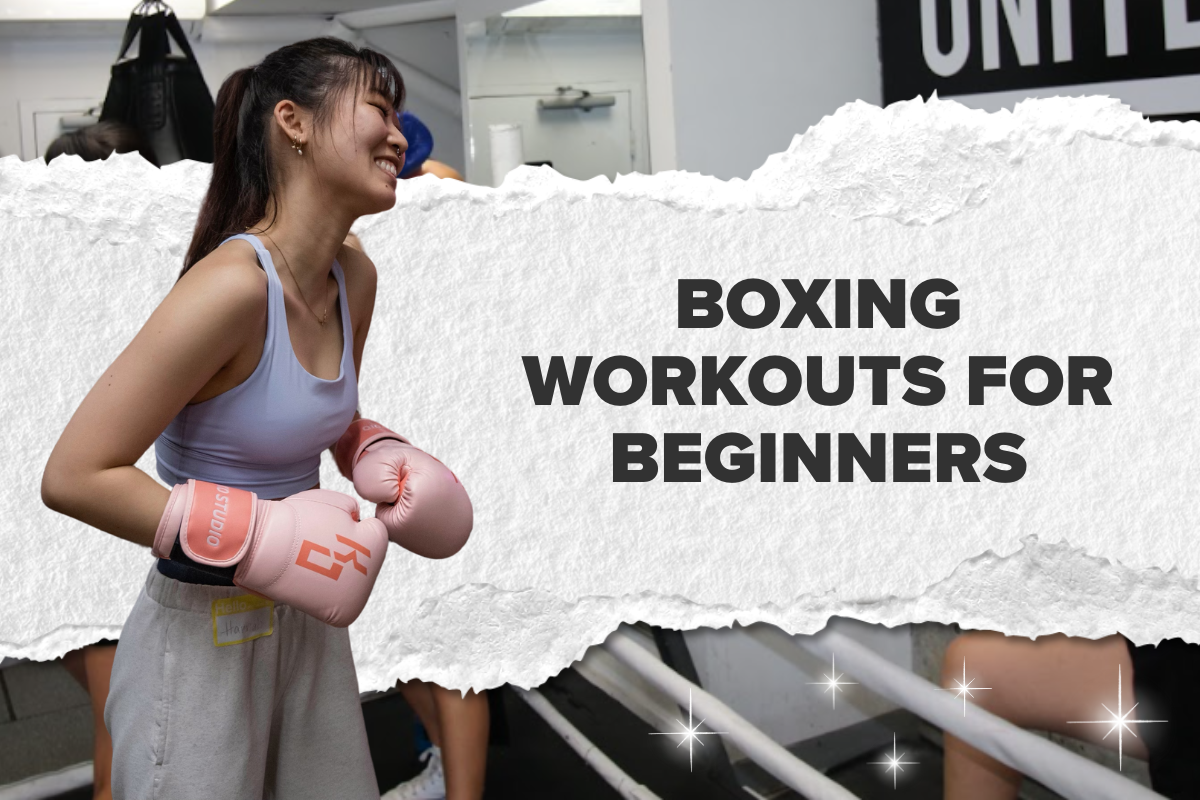Introduction
Boxing is more than just a sport—it’s a transformative fitness journey that builds not only physical strength but also mental resilience. Whether you're aiming to get fit, learn self-defense, or simply try something new, boxing offers a dynamic and empowering workout. This guide is tailored specifically for beginners who want to ease into the world of boxing with confidence, safety, and effectiveness.
We’ll walk you through the basics: from understanding key punches and stances to exploring beginner-friendly routines and choosing the right gear. You'll also find recommendations from KO Studio, a leader in boxing equipment designed especially for women. Let’s get started!
The Health Benefits of Boxing for Beginners
Cardiovascular Conditioning
Boxing elevates your heart rate and improves overall cardiovascular health. It combines aerobic (steady-state) and anaerobic (high-intensity) activity, making it one of the most effective workouts for heart and lung endurance.
Full-Body Muscle Engagement
Every punch thrown engages your core, arms, shoulders, and legs. Unlike isolated gym workouts, boxing involves compound movements that strengthen and tone multiple muscle groups simultaneously.
Stress Relief and Mental Focus
Punching a heavy bag or shadowboxing is a great outlet for stress. The rhythm, intensity, and focus boxing requires help improve mental clarity and reduce anxiety. Many beginners find boxing to be as mentally rewarding as it is physically challenging.
Essential Boxing Gear for Beginners
Boxing Gloves
A quality pair of gloves is crucial. Brands like KO Studio offer ergonomically designed gloves tailored for female athletes, ensuring both style and support. For beginners, 12-16 oz gloves are generally recommended for training and bag work.
Hand Wraps
Protecting your hands and wrists is vital. Hand wraps—like the stylish Celestial or Cherry Blossom wraps from KO Studio—offer support and reduce the risk of injury by stabilizing joints and cushioning impacts.
Jump Rope
Jumping rope is a staple of boxing warm-ups. It enhances footwork, cardio, and coordination. Beginners should start with short intervals and gradually build endurance.
Heavy Bag vs. Shadowboxing
Heavy bags offer resistance and feedback, ideal for developing power. Shadowboxing, on the other hand, improves form, rhythm, and technique without impact. A mix of both is ideal for beginners to develop balance and confidence.
Key Boxing Terms and Concepts You Should Know
Jab, Cross, Hook, Uppercut
These are the four fundamental punches in boxing. The jab is a quick, straight punch with your lead hand. The cross is a powerful straight punch with your rear hand. Hooks target the sides of the head or body, and uppercuts are upward punches aimed at the chin.
Guard, Footwork, and Stance
Your guard protects your face and torso using your hands and arms. Footwork is how you move efficiently and maintain balance, while your stance (orthodox or southpaw) determines how you face your opponent. Mastering these basics is essential before throwing punches.
How to Choose the Right Boxing Style
Out-Boxer vs. Pressure Fighter
An out-boxer focuses on long-range punches, speed, and movement. A pressure fighter thrives up close, using volume punching and constant pressure. Beginners can experiment with both to see which feels more natural.
Southpaw vs. Orthodox
An orthodox stance means leading with your left foot and hand (common for right-handed people), while a southpaw stance leads with the right. Try both to see which offers better balance and control for you.
Warm-Up Routine Before Every Boxing Session
Dynamic Stretching
Before jumping into any punches, loosen up your muscles with dynamic movements like arm circles, leg swings, and torso twists. This improves circulation and reduces injury risk.
Jump Rope: How Long and Why
Jump rope for 3-5 minutes to get your heart rate up and enhance coordination. It's an excellent way to simulate boxing’s fast-paced rhythm while warming up your body efficiently.
Mobility Drills for Shoulders and Hips
Use light resistance bands or bodyweight exercises like hip openers and shoulder rolls to increase joint mobility. Good mobility ensures better punching mechanics and helps prevent injuries.
Basic Boxing Stance and Footwork
How to Stand Properly
Your feet should be shoulder-width apart with your knees slightly bent. For orthodox stance, your left foot is forward; for southpaw, your right foot leads. Keep your chin tucked and hands up near your cheeks.
Weight Distribution
Distribute your weight evenly on the balls of your feet, not your heels. This helps you stay light, quick, and responsive. Avoid being flat-footed as it limits your mobility.
Movement Drills for Beginners
Practice stepping forward, backward, and side-to-side while maintaining your stance. A basic drill: move in each direction for 30 seconds without losing your form. Use mirrors or videos to self-correct posture and balance.
Beginner Boxing Punch Techniques
Jab and Cross Breakdown
The jab (lead hand) sets up combinations and maintains distance. The cross (rear hand) delivers power. Practice these punches slowly at first, ensuring correct form: rotate your hips, extend your arm, and quickly return to guard.
Hook and Uppercut Fundamentals
Hooks are circular punches targeting the opponent's head or ribs. Uppercuts are upward punches aimed at the chin. Use your legs and torso rotation to generate force. Always keep your other hand in guard while throwing punches.
Common Punching Mistakes
-
Dropping your non-punching hand
-
Overextending your reach
-
Punching without rotating your hips
Use slow-motion practice to identify and correct these habits.
Defensive Techniques for Beginners
Basic Guard Position
Always keep your hands up to protect your face, with elbows tucked in to guard your torso. Your gloves should stay at cheek level, and your chin slightly down to minimize target exposure.
Slips, Rolls, and Blocks
Slipping means moving your head slightly left or right to avoid straight punches. Rolling involves bending your knees and rolling your upper body under a hook. Blocking uses your gloves and forearms to absorb strikes. Mastering these movements enhances your defensive skills and overall agility.
Shadowboxing: The Beginner’s Secret Weapon
What is Shadowboxing?
Shadowboxing is the act of sparring with an invisible opponent. It helps develop rhythm, form, and mental visualization without the need for equipment. It’s perfect for refining technique and warming up.
Sample 3-Round Shadowboxing Routine
-
Round 1: Focus on footwork and basic punches (jab, cross)
-
Round 2: Add in combinations and head movement
-
Round 3: Visualize an opponent and practice defense (slips, rolls, blocks)
Each round can be 2–3 minutes long with a 1-minute rest in between.
Heavy Bag Workouts for Beginners
How to Hit the Heavy Bag Properly
Focus on technique, not power. Start with simple combos like jab-cross or jab-jab-cross. Always reset your stance after each combination. Keep your hands up and maintain movement to simulate a real fight.
Sample 20-Minute Bag Workout
-
Round 1: Jab-cross combinations (2 minutes)
-
Round 2: Add hooks and uppercuts (2 minutes)
-
Round 3: Defensive movement + counter punches (2 minutes)
-
Round 4: Free combo flow (2 minutes)
-
Rest: 1-minute break between rounds
Boxing Combinations for Beginners
1-2 (Jab-Cross)
The most fundamental combo in boxing. Use the jab to measure distance and the cross to deliver force. Practice this on the bag, pads, or in shadowboxing.
1-2-3 (Jab-Cross-Hook)
Add a lead hook after the cross to break through an opponent’s defense. Rotate your body with each punch to build power and fluidity.
Drills to Improve Speed and Accuracy
Try interval drills: throw 1-2s nonstop for 20 seconds, rest 10 seconds, repeat for 3 rounds. Use a mirror or record yourself to evaluate form and speed. For added precision, practice on focus mitts or target pads.
Conditioning and Strength Training for Boxing
Bodyweight Circuits
Boxing relies heavily on bodyweight strength. Incorporate exercises like push-ups, squats, lunges, and planks into a 15–20 minute circuit, resting minimally between sets to build stamina and muscle endurance.
Core Training Focus
A strong core enhances punch power and balance. Add exercises such as Russian twists, leg raises, and mountain climbers. Aim for 3 sets of 30 seconds per movement to build boxing-specific core strength.
HIIT for Boxing
High-Intensity Interval Training mimics the round-based nature of boxing. Try 30 seconds of burpees, followed by 30 seconds of rest, repeated for 4–5 rounds. Combine HIIT with shadowboxing or bag work for maximum effect.
Sample Weekly Boxing Workout Plan for Beginners
3-Day Plan
-
Day 1: Technique + Shadowboxing
-
Day 2: Conditioning + Bag Work
-
Day 3: Strength Training + Light Combinations
5-Day Plan
-
Day 1: Footwork + Basic Punches
-
Day 2: Bag Work + Core Training
-
Day 3: HIIT + Shadowboxing
-
Day 4: Combinations + Defense Drills
-
Day 5: Strength Circuits + Cool Down
Include 1–2 rest or active recovery days each week to prevent burnout and promote muscle recovery.
Common Mistakes Beginners Should Avoid
Overtraining or Undertraining
Training too much can lead to fatigue or injury, while too little slows progress. Follow a structured plan with rest days to keep your body balanced and healthy.
Poor Form and Lack of Guard
Improper technique reduces effectiveness and increases injury risk. Always prioritize form over speed or power, and keep your guard up at all times.
Ignoring Rest and Nutrition
Recovery is just as important as training. Make sure to get adequate sleep, stay hydrated, and consume a diet rich in lean proteins, complex carbs, and healthy fats to fuel your workouts.
Tips to Stay Motivated and Track Your Progress
Using a Boxing Journal
Keep a training log to track your workouts, punches learned, combinations practiced, and personal reflections. This reinforces discipline and makes it easier to see improvements over time.
Joining a Local Boxing Gym or Online Program
Community helps with accountability. Whether it's a physical boxing gym or an online program, surrounding yourself with like-minded individuals will boost motivation and skill development. KO Studio’s community-centered gear supports this very mission.
Setting Short-Term Goals
Break your goals down into smaller, measurable achievements. Whether it's completing your first full combo without error or hitting the bag for a full 3-minute round, celebrate every milestone.
Nutrition Tips to Support Your Boxing Journey
Pre-Workout and Post-Workout Meals
Before training, fuel up with a mix of complex carbs (like oats or brown rice) and lean protein (like chicken or tofu). Post-workout, focus on replenishment with a protein shake or a balanced meal that includes healthy fats and greens.
Hydration
Boxing can be extremely sweat-inducing. Always drink water before, during, and after your session. For intense workouts, add electrolytes to your hydration plan.
Supplements: Yes or No?
Most beginners don’t need supplements, but protein powders and magnesium can aid recovery. Always consult a professional before adding supplements to your routine.
When and How to Level Up Your Training
Moving from Beginner to Intermediate
Once you’re confident with basic punches, combos, and defense, it’s time to move up. Start increasing intensity, adding more rounds, and reducing rest time.
Adding Sparring, Coaching, or Classes
Live feedback is invaluable. Consider hiring a coach or joining a sparring class at your local gym to refine your form, timing, and fight IQ. Ensure you have the right protective gear, including mouthguards and headgear.
Conclusion
Boxing is an incredible way to build fitness, focus, and inner strength. By starting with solid fundamentals and staying consistent, you’ll progress from novice to confident striker in no time. Equip yourself with the right gear, stay disciplined, and always protect your guard—both physically and mentally. Whether training at home or in a gym, boxing is a lifelong skill that transforms your body and mind.
FAQs
Is boxing good for weight loss?
Absolutely. Boxing is a high-intensity workout that torches calories, boosts metabolism, and builds lean muscle—all essential for effective fat loss.
How long should a beginner train per day?
Start with 30 to 45-minute sessions, 3 to 5 times a week. Focus on quality over quantity, gradually increasing duration as your stamina improves.
Do I need a partner to train boxing?
No. Shadowboxing, heavy bag workouts, and online tutorials allow you to train solo effectively. However, having a partner can be beneficial for pad work and motivation.
Can I learn boxing at home?
Yes, especially with so many online resources available. Invest in basic gear and follow a structured plan. KO Studio also provides gear designed for home boxers.
How soon can I see results from boxing workouts?
Most beginners notice improved stamina, strength, and mood within 2–4 weeks. Visible physical changes typically occur around the 6–8 week mark with consistent training.



